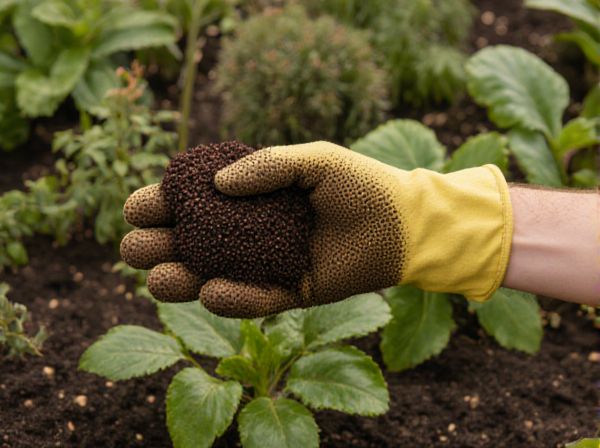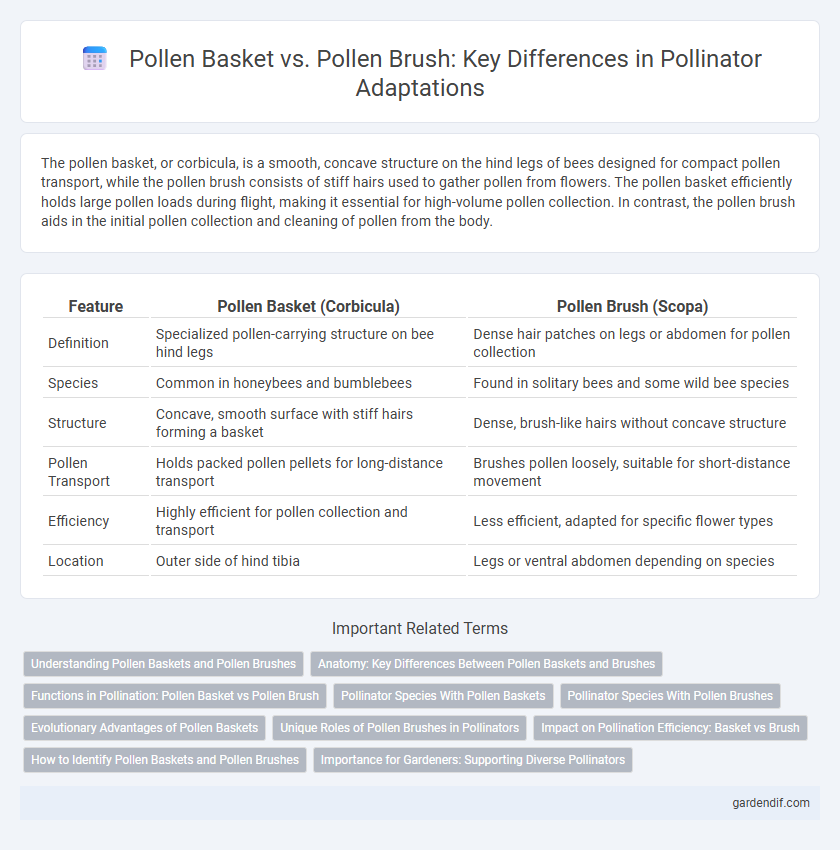
Pollen Basket vs Pollen Brush Illustration
The pollen basket, or corbicula, is a smooth, concave structure on the hind legs of bees designed for compact pollen transport, while the pollen brush consists of stiff hairs used to gather pollen from flowers. The pollen basket efficiently holds large pollen loads during flight, making it essential for high-volume pollen collection. In contrast, the pollen brush aids in the initial pollen collection and cleaning of pollen from the body.
Table of Comparison
| Feature | Pollen Basket (Corbicula) | Pollen Brush (Scopa) |
|---|---|---|
| Definition | Specialized pollen-carrying structure on bee hind legs | Dense hair patches on legs or abdomen for pollen collection |
| Species | Common in honeybees and bumblebees | Found in solitary bees and some wild bee species |
| Structure | Concave, smooth surface with stiff hairs forming a basket | Dense, brush-like hairs without concave structure |
| Pollen Transport | Holds packed pollen pellets for long-distance transport | Brushes pollen loosely, suitable for short-distance movement |
| Efficiency | Highly efficient for pollen collection and transport | Less efficient, adapted for specific flower types |
| Location | Outer side of hind tibia | Legs or ventral abdomen depending on species |
Understanding Pollen Baskets and Pollen Brushes
Pollen baskets, also known as corbiculae, are specialized structures located on the hind legs of bees, designed to efficiently collect and transport pollen back to the hive. Pollen brushes consist of dense, stiff hairs found on various parts of a bee's body, which help gather pollen before transferring it to the pollen baskets. Understanding these adaptations highlights the critical role of pollen baskets in storage and transport, while pollen brushes function primarily in initial pollen collection and manipulation.
Anatomy: Key Differences Between Pollen Baskets and Brushes
Pollen baskets, or corbiculae, are concave, smooth structures located on the hind legs of honeybees and bumblebees, designed to transport large quantities of pollen efficiently. In contrast, pollen brushes consist of dense, stiff hairs found on the front legs of many bee species, specialized for collecting and transferring pollen grains. The key anatomical difference lies in the pollen basket's storage capability versus the pollen brush's role in gathering pollen before it is packed into the basket.
Functions in Pollination: Pollen Basket vs Pollen Brush
The pollen basket, or corbicula, functions as a storage area on the hind legs of bees, allowing them to transport large quantities of pollen back to the hive efficiently. In contrast, the pollen brush, composed of dense hairs on the forelegs, is primarily used to collect and transfer pollen grains from flowers onto the corbicula. Both structures play crucial roles in pollination by ensuring effective pollen collection and transportation, which enhances plant fertilization and biodiversity.
Pollinator Species With Pollen Baskets
Pollinator species with pollen baskets, such as honeybees and bumblebees, have specialized structures called corbiculae on their hind legs that efficiently gather and transport pollen back to the hive. These pollen baskets provide a smooth, concave surface surrounded by stiff hairs, allowing large quantities of pollen to be compacted and secured during flight. In contrast, pollinators with pollen brushes, like many solitary bees, use dense hairs to collect pollen, but lack the compacting feature of pollen baskets, making pollen transport less efficient for large-scale colony foragers.
Pollinator Species With Pollen Brushes
Several pollinator species, such as certain solitary bees and butterflies, feature pollen brushes instead of pollen baskets for collecting pollen. These stiff, dense hairs located on the legs or body allow efficient pollen adherence and transport during foraging. Species with pollen brushes exhibit specialized grooming behaviors to maximize pollen transfer between flowers, enhancing their role in ecosystem pollination.
Evolutionary Advantages of Pollen Baskets
Pollen baskets, or corbiculae, are specialized structures on the hind legs of certain bee species that provide efficient pollen transport, enhancing foraging success by allowing larger pollen loads and reducing pollen loss. Compared to pollen brushes, pollen baskets offer evolutionary advantages in energy conservation and increased reproductive fitness by enabling bees to collect and carry more pollen to the hive. This adaptation supports improved colony nutrition and survival, optimizing pollination efficiency in diverse ecosystems.
Unique Roles of Pollen Brushes in Pollinators
Pollen brushes, found on the legs or bodies of certain pollinators like bees, serve the unique role of efficiently gathering and transferring pollen grains from flowers to ensure effective pollination. Unlike pollen baskets, which primarily store collected pollen during flight, pollen brushes actively comb and collect pollen from floral surfaces, enhancing the precision and volume of pollen collection. This functional specialization of pollen brushes directly influences pollination success and plant reproduction by maximizing pollen transfer efficiency.
Impact on Pollination Efficiency: Basket vs Brush
The pollen basket, or corbicula, allows bees to transport large quantities of pollen efficiently on their hind legs, enhancing pollination range and plant cross-pollination success. In contrast, the pollen brush, composed of dense hairs on the bee's legs, collects smaller pollen loads, which may result in more pollen being deposited directly onto flowers during foraging, increasing immediate pollination effectiveness. The choice between basket and brush influences pollination efficiency by balancing pollen transport capacity with direct pollen transfer frequency.
How to Identify Pollen Baskets and Pollen Brushes
Pollen baskets, or corbiculae, are smooth, concave structures located on the hind legs of bees, often surrounded by stiff hairs that hold compact pollen loads. Pollen brushes, found in various bee species, consist of dense, brush-like hairs on the hind legs used to collect and transport pollen grains loosely. Identification relies on observing whether the pollen is tightly packed in a smooth, scooped area (pollen basket) or clinging to a hairy, brush-like surface (pollen brush).
Importance for Gardeners: Supporting Diverse Pollinators
Pollen baskets, specialized structures found on the hind legs of bees like honeybees and bumblebees, enable efficient transport of pollen back to the hive, supporting colony health and pollination effectiveness. Pollen brushes, smaller hairs on other pollinators such as solitary bees and butterflies, help gather pollen for individual nourishment and facilitate cross-pollination across diverse plant species. Understanding and supporting both pollen baskets and brushes are crucial for gardeners aiming to maintain a thriving ecosystem that encourages a variety of pollinators, enhancing plant reproduction and biodiversity.
Pollen Basket vs Pollen Brush Infographic

 gardendif.com
gardendif.com